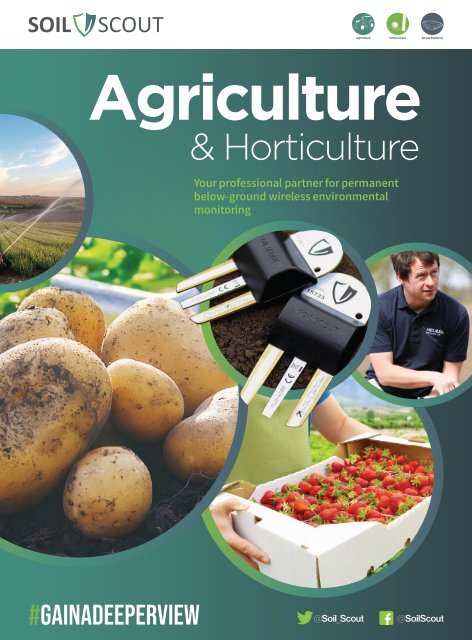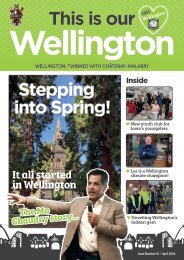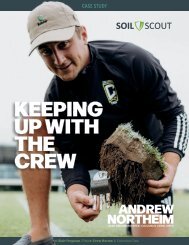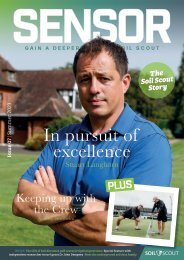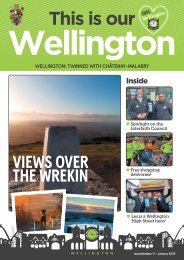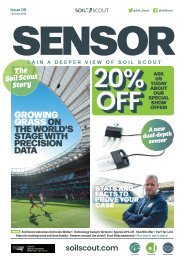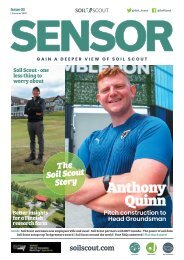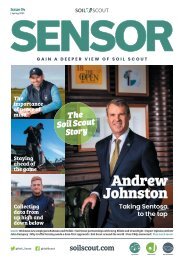You also want an ePaper? Increase the reach of your titles
YUMPU automatically turns print PDFs into web optimized ePapers that Google loves.
<strong>Agriculture</strong><br />
Golf Courses<br />
Sports Stadiums<br />
<strong>Agriculture</strong><br />
& Horticulture<br />
Your professional partner for permanent<br />
below-ground wireless environmental<br />
monitoring<br />
#GainADeeperView<br />
@<strong>Soil</strong>_<strong>Scout</strong><br />
@<strong>Soil</strong><strong>Scout</strong>
The <strong>Soil</strong> <strong>Scout</strong> story....<br />
‘The first prototype is still buried<br />
and beeping 13 years later . . .’<br />
In the year 2000, agrotechnology student and 19th<br />
generation farmer Johannes Tiusanen wrote an<br />
essay on future farming at the University of Helsinki,<br />
in which he stated that farmers in 2025 “will get online<br />
reports on underground soil conditions - just like a<br />
local weather report.”<br />
He realised the sensors that captured this data would<br />
need to be permanently buried, but no one knew<br />
why mobile signals attenuated when underground.<br />
He answered this question while completing his<br />
doctorate, which led to the creation of a new kind of<br />
antenna.<br />
With the help of his good friend, Jussi Sirkiä, who had<br />
an abundance of experience in power electronics,<br />
the pair were able to build a new product that could<br />
transmit enormous amounts of radio power while<br />
maintaining a lower power state the rest of the time<br />
and last for 20 years buried underground. The first<br />
prototype is still buried and beeping 13 years later.<br />
Having initially built the product to solve his own<br />
problems, Johannes realised the potential of the<br />
technology as a commercial solution and founded <strong>Soil</strong><br />
<strong>Scout</strong> in 2013. The team solved the final piece of the<br />
puzzle - they refined the solution to the point where<br />
a person can take their phone out of their pocket and<br />
understand what is happening underground in realtime.<br />
Our mission is to give soil experts the insights and<br />
data they need to manage their lands in the most<br />
efficient and effective ways. Through data, we will<br />
safeguard our soils and make them flourish for future<br />
generations.<br />
Johannes Tiusanen<br />
Chief Science Officer, <strong>Soil</strong> <strong>Scout</strong><br />
#thesoilscoutstory<br />
“We wanted to help<br />
farmers and growers get<br />
the insights they need from<br />
the soil they manage”<br />
The <strong>Soil</strong> <strong>Scout</strong> timeline....<br />
2000<br />
Johannes wrote<br />
an essay on<br />
future farming at<br />
University<br />
2004<br />
Development<br />
of a unique<br />
underground<br />
antenna<br />
2005<br />
Johannes and Jussi<br />
produced their first<br />
wireless soil<br />
sensor<br />
2<br />
www. .com #GainADeeperView
<strong>Agriculture</strong><br />
Golf Courses<br />
Sports Stadiums<br />
Welcome to <strong>Soil</strong> <strong>Scout</strong><br />
Traditional farming has successfully treated each<br />
field differently according to experience and<br />
scientific advice, but the next leap demands<br />
something more. In the process of learning how<br />
to treat in-field zones individually, the constantly<br />
evolving Smart Farming requires real-time data and<br />
recorded feedback on every action. <strong>Soil</strong> <strong>Scout</strong> expands<br />
that revolution to the underground.<br />
<strong>Soil</strong> <strong>Scout</strong> provides the only wireless sensors capable<br />
of transmitting moisture, temperature and salinity<br />
data in near real-time out-of-sight performance from<br />
up to two metres / six feet below the surface, for up to<br />
20 years, maintenance free.<br />
Understanding what’s happening below the soil<br />
surface is critical for many industries. <strong>Soil</strong> <strong>Scout</strong> takes<br />
monitoring to the next level by providing a detailed<br />
view into in-field variation, enabling our customers<br />
to expand the Precision <strong>Agriculture</strong> approach to all<br />
land use challenges, be that smart farming, irrigation<br />
control or turf quality optimization.<br />
Previous solutions for measuring environmental<br />
conditions are based on wires and cables or a single<br />
observation pole, which are impractical, inefficient,<br />
labour-intensive or unable to assess spatial variability.<br />
<strong>Soil</strong> <strong>Scout</strong> provides critical insight into data from deep<br />
below the surface wirelessly, enabling 365x24 insight<br />
and profiling which allows our customers to perform<br />
better, understand their operations deeper and reduce<br />
water and energy use by up to 50%.<br />
Read more<br />
4 Why choose <strong>Soil</strong> <strong>Scout</strong><br />
5 Case study<br />
Juha Liespuu Head of Yara Kotkaniemi Research Farm<br />
6 What does <strong>Soil</strong> <strong>Scout</strong> do?<br />
Benefits from using wireless sensor technology<br />
in agriculture and horticulture<br />
7 Key benefits and case study<br />
“<strong>Soil</strong> <strong>Scout</strong> - the way to go in modern agriculture”, says<br />
Felix Hacker from Du Roi Nursery<br />
8/9 Gain a deeper view<br />
Smart Farming - the <strong>Soil</strong> <strong>Scout</strong> solution to the modern<br />
challenges facing farmers and growers<br />
10 Wireless underground soil sensor<br />
Make informed decisions based on accurate<br />
and permanent measurements<br />
11 Case study<br />
“We would recommend <strong>Soil</strong> <strong>Scout</strong> to any other farmer<br />
or grower”, says Heino Malan from Haygrove Eden<br />
12 New products for <strong>Agriculture</strong><br />
Introducing the new Dual Depth sensor<br />
13 <strong>Soil</strong> <strong>Scout</strong> wins <strong>Agriculture</strong> award<br />
Top Techpreneurs agriculture award for <strong>Soil</strong> <strong>Scout</strong><br />
14 FAQ<br />
<strong>Soil</strong> <strong>Scout</strong> answers your frequently asked questions<br />
15 Technical specifications<br />
HYDRA100 <strong>Scout</strong> / Base Station / ECHO Repeater<br />
16 Contact <strong>Soil</strong> <strong>Scout</strong> and your distributor<br />
2013<br />
<strong>Soil</strong> <strong>Scout</strong> is<br />
founded and<br />
welcomes first<br />
Angel investor<br />
2015<br />
Release of<br />
the latest<br />
HYDRA100<br />
sensor<br />
2019<br />
Husqvarna<br />
becomes the latest<br />
to invest in<br />
<strong>Soil</strong> <strong>Scout</strong><br />
#UndergroundWeather www. .com 3
Why choose <strong>Soil</strong> <strong>Scout</strong>?<br />
In the absence of accurate data the agriculture<br />
industry can be forgiven for being responsible for<br />
over irrigation. According to studies more than 25%<br />
of irrigated water is actually wasted by growers not<br />
having the correct information from their soil.<br />
The effects of over watering lead on and create a<br />
devastating trail of after effects.<br />
By using <strong>Soil</strong> <strong>Scout</strong>s wireless underground sensors,<br />
these issues won’t be cured, but you can go a long<br />
way to putting it right and gaining significant savings,<br />
and dramatically increasing your efficiencies along the<br />
way.<br />
Sustainability is the word on everyone’s minds right<br />
now, and with the ever increasing costs of all inputs, all<br />
involved in decision making within this sector, need to<br />
use water (admittedly our most valuable resource) as<br />
efficiently as possible.<br />
The <strong>Soil</strong> <strong>Scout</strong> story....<br />
#thesoilscoutstory<br />
“You can see all the data from your phone instead of going to the<br />
field. A farmer or grower can stay at home and check the conditions<br />
from the <strong>Soil</strong> <strong>Scout</strong> app”<br />
Tommi Tienhaara<br />
Sales, <strong>Soil</strong> <strong>Scout</strong><br />
#thesoilscoutstory<br />
4<br />
www.<br />
.com<br />
#GainADeeperView
Case Study<br />
<strong>Agriculture</strong><br />
Golf Courses<br />
Sports Stadiums<br />
Yara R&D<br />
Yara Kotkaniemi Research Farm<br />
Yara Kotkaniemi Research Farm has been part of Yara’s<br />
R&D organization since 2016, but its roots date back<br />
several decades and it still is an important trial site<br />
for testing modern farmer tools. After all, knowledge and<br />
innovation drives the yield, and yield drives sustainability and<br />
profitability.<br />
In 2014 we were looking for a solution to dynamically monitor<br />
and record soil conditions in our famous and recognised longterm<br />
fertilizer and tillage management experiments, which<br />
have been running for many decades. The technology that <strong>Soil</strong><br />
<strong>Scout</strong> was just bringing to the market was a perfect fit. Being<br />
a spin-off from the honourable Helsinki University helped the<br />
young start-up gain sufficient credibility.<br />
During half a decade of collaboration with <strong>Soil</strong> <strong>Scout</strong> we have<br />
witnessed the many leaps in their product development. While<br />
the introduction of the very first solar powered Echo Repeaters<br />
in 2017 allowed us to expand the setup to distant fields, the<br />
Base Stations still are the very earliest versions and they keep<br />
running.<br />
Long-term trials require long-term data and permanently buried<br />
sensors provide just that. Today, data is used, for example, in<br />
various modellings related to plant nutrition.<br />
Juha Liespuu<br />
Yara<br />
Head of Kotkaniemi Research Farm<br />
Accumulating records of the remarkable moisture and<br />
temperature differences which no-till, cultivation and ploughing<br />
plot profiles demonstrate, builds up an invaluable asset for us to<br />
recognize trends and pattern as the natural environment keeps<br />
becoming more and more challenging.<br />
Our aim is to develop the range of fertilizers and fertilization<br />
methods to better meet current and future needs, and <strong>Soil</strong> <strong>Scout</strong><br />
helps us in doing so.<br />
“During half a decade of collaboration with <strong>Soil</strong><br />
<strong>Scout</strong> we have witnessed the many leaps in<br />
their product development”<br />
#UndergroundWeather www. .com 5
What does <strong>Soil</strong> <strong>Scout</strong> do?<br />
Benefits from using wireless sensor technology in agriculture and horticulture<br />
The soil moisture, temperature and salinity are three critical<br />
components to monitor, if you are looking to achieve optimum<br />
conditions for plant health, and ideal growth.<br />
Historically farmers, growers and agronomists have known their own wants,<br />
when it has come to what’s needed to achieve optimum growing conditions.<br />
But now, with our underground moisture, soil temperature and salinity<br />
sensor, we can make that job more efficient, and streamlined, from many<br />
levels. Increasing awareness of in-field variation, ecological sustainability,<br />
auditable actions and simpler, connected management practices.<br />
After learning the interpretation of the data you receive, and how it benefits<br />
you and your farm personally, it is an added asset to the arsenal of tools at<br />
your disposal to influence many factors through your growing cycles.<br />
The <strong>Soil</strong> <strong>Scout</strong> cycle....<br />
<br />
<br />
<br />
<br />
<br />
<br />
6 www. .com<br />
#GainADeeperView
Key benefits<br />
<strong>Agriculture</strong><br />
Golf Courses<br />
Sports Stadiums<br />
<strong>Soil</strong> <strong>Scout</strong> is the only soil sensor solution which<br />
you can freely distribute across a field - install<br />
and forget!<br />
Case Study<br />
Smart sensor placement provides real-time<br />
monitoring of areal differences and enables<br />
treating each area individually and optimally<br />
- <strong>Soil</strong> <strong>Scout</strong> staff will assist you in choosing the<br />
best locations.<br />
The sensors operate out of sight year-to-year<br />
providing you with a long-term view into soil<br />
behaviour, enabling accurate and informed<br />
soil management instead of traditions and<br />
guesswork, but also build up long-time<br />
records for your future needs.<br />
The accurate and consistent data enables<br />
you to observe patterns and seek for growth<br />
limiting factors efficiently - by eg., observing<br />
draught, wetness, poor drainage, inhibited<br />
infiltration, water availability, soil compaction<br />
and more.<br />
When irrigating, instant before / during / after<br />
data enables both quick reactions and longterm<br />
ability to maintain optimal soil moisture<br />
and save irrigation costs.<br />
With the underground weather map, apply just<br />
the right amount of inputs at the right places<br />
at the right time, and gradually improve the<br />
soil through even better farming practices.<br />
<strong>Soil</strong> <strong>Scout</strong> - the way to go<br />
in modern agriculture<br />
The <strong>Soil</strong> <strong>Scout</strong> system that we are using is definitely the way to<br />
go in modern agriculture. The mere fact that you can login to real<br />
time data from anywhere in the world is already a huge benefit.<br />
Added to that is the ease of use if compared to our existing<br />
system where we use Tensio-meters that need constant priming<br />
and physical readings.<br />
Once the data correlation and interpretation has been done the<br />
<strong>Soil</strong> <strong>Scout</strong> information will be of even more benefit as it will also<br />
give us an indication of the fertilization levels. The <strong>Soil</strong> <strong>Scout</strong><br />
probes seem to be very robust and it will be interesting to see<br />
how they last over the long term.<br />
Technical backup to the product has been good and the <strong>Soil</strong><br />
<strong>Scout</strong> team was eager to help and support.<br />
Felix Hacker<br />
Du Roi Nursery<br />
South Africa<br />
Sensors run up to 20 years below the ground<br />
without any maintenance – making it the most<br />
cost-efficient solution.<br />
The monitored soil area is easy to expand by<br />
simply adding more sensors to the system – no<br />
need for complicated pairing, new SIM cards,<br />
or data subscriptions.<br />
The dashboard visualizes soil moisture,<br />
salinity and temperature data in many<br />
intuitive ways - you can easily check current<br />
status, follow trends, recognise patterns and<br />
compare soil conditions in different areas,<br />
anytime and anywhere using any device with<br />
a browser.<br />
#UndergroundWeather<br />
www.<br />
.com<br />
7
#GainADeeperView<br />
@<strong>Soil</strong>_<strong>Scout</strong><br />
@<strong>Soil</strong><strong>Scout</strong><br />
Farming Today<br />
Farming is expected to feed the growing population and serve new consumer trends,<br />
which demand high-standard food supplies produced with sustainable methods<br />
and delivered through transparent supply chains. Despite the increasing demand,<br />
commodity prices remain low, and farmers need to control costs.<br />
Water scarcity is critical. As agriculture consumes 69% of water globally, farmers need to<br />
find safe ways to reduce water consumption without jeopardizing crops. It’s no longer<br />
possible to increase production by converting more land to farming due to irreversible<br />
ecological damages. Instead, the efficiency of existing farm fields must be improved<br />
sustainably and smartly.<br />
The <strong>Soil</strong> <strong>Scout</strong> story....<br />
#thesoilscoutstory<br />
“We helped them manage the entire system in a simple way, and they<br />
received real information on the value of their soil for the first time. We<br />
helped them leverage smart farming techniques”<br />
Jalmari Talola<br />
CEO, <strong>Soil</strong> <strong>Scout</strong><br />
8 www. .com
The <strong>Soil</strong> <strong>Scout</strong> story....<br />
“We’re giving farmers data for better problem assessment. We’re<br />
replacing guesswork with actual real-time view of something that<br />
has been hidden - underground soil data. We help them turn this<br />
data into management practices - they get tangible, actionable<br />
information”<br />
Johannes Tiusanen<br />
Chief Science Officer, <strong>Soil</strong> <strong>Scout</strong><br />
#thesoilscoutstory<br />
The Challenge<br />
How do you produce higher crops with better quality while<br />
reducing costs and using less water and more sustainable farming<br />
methods? How do you accomplish this profitably amid the<br />
ever-challenging and unpredictable weather and environmental<br />
conditions?<br />
If traditional weather observations and appliances could provide<br />
the required accurate and timely information, the problem would<br />
have been all gone by now.<br />
Our Solution<br />
Smart Farming<br />
<strong>Agriculture</strong> has gone through several revolutions – from the domestication of plants and animals to selective breeding,<br />
fertilization, and mechanization. The next agricultural revolution is Smart Farming enabled by measured observations, real-time<br />
data, and recorded feedback.<br />
However, the missing link in Precision <strong>Agriculture</strong> has been the soil itself — how to bring underground phenomena up to speed<br />
with real-time telemetry, optical crop sensing, and variable rate applications. Disconnecting visible plant observations from<br />
what actually happens in the root zone leads to inadequate understanding and even incorrect conclusions.<br />
At last, <strong>Soil</strong> <strong>Scout</strong> sensors expand the Smart Farming revolution to the underground.<br />
The solution collects accurate root zone data from below ground where the growth really takes place; sends this data to the<br />
Monitoring Service, which turns it into meaningful information for farmers who can now tackle their most substantial challenges<br />
– and improve crop productivity and quality sustainably while reducing operational costs and water consumption.<br />
www.<br />
.com<br />
9
Wireless underground<br />
soil monitoring sensor<br />
Make informed decisions based on accurate and permanent measurements<br />
<strong>Soil</strong> <strong>Scout</strong><br />
l Integrated moisture, temperature and EC (salinity)<br />
sensors<br />
l Transmits from up to two metres underground<br />
l Broadcasts through soil, turf, sand, clay,<br />
biomass, snow and concrete<br />
l Nothing on field to interfere with machinery,<br />
post-tillage practices or plant growth<br />
l Create a multidimensional picture of<br />
subsoil environment<br />
Features<br />
l Broadcasts every 20 minutes for up to<br />
20 years (other intervals available)<br />
l Data transmitted to a gateway and onwards<br />
to the Monitoring Service<br />
l Water and energy savings up to 50%<br />
l Unaffected by weather, temperature<br />
extremes or seasons<br />
l Enables detailed profile to be established<br />
continuously over time<br />
l Ability to integrate with third party systems or<br />
machinery (irrigation, farm management software)<br />
Patented Technology<br />
Regular radio antennas do not work properly if buried in<br />
soil because the speed of radio waves varies depending on<br />
soil properties. This is why an antenna for a specific wave<br />
length would go out of tune when soil moisture changes.<br />
<strong>Soil</strong> <strong>Scout</strong> has developed a patented underground<br />
antenna that interacts with the surrounding medium in a<br />
way that balances the antenna input to the prevailing soil<br />
conditions. As a result, the antenna is not very efficient<br />
in air, but gains an efficiency exceeding 95% when soil is<br />
introduced to the antenna near field.<br />
US9673912B2<br />
#GainADeeperView<br />
@<strong>Soil</strong>_<strong>Scout</strong><br />
@<strong>Soil</strong><strong>Scout</strong><br />
10 www. .com<br />
#GainADeeperView
<strong>Agriculture</strong><br />
Golf Courses<br />
Sports Stadiums<br />
Case Study<br />
We would recommend<br />
<strong>Soil</strong> <strong>Scout</strong> to any other<br />
farmer or grower<br />
I have used all types of soil moisture probes over the past<br />
12 seasons growing in Substrate. However you never<br />
get exactly what you want with one product, as there is<br />
always something missing. There are five things that a<br />
good moisture probe should be and do: measure moisture<br />
consistently, capture soil/medium temperature, capture<br />
electric conductivity accurately, be user friendly and<br />
flexibility to adapt to each grower’s needs.<br />
<strong>Soil</strong> <strong>Scout</strong> does all of these things. It was originally<br />
developed as a soil moisture probe, not meant for<br />
substrate growing. But with the flexibility of the software<br />
they could adapt the readings so that we could also<br />
use it in our industry for monitoring and as a nutrient<br />
management tool.<br />
We have used it for a full season and are delighted with<br />
the results. We recommend it to any other grower,<br />
whether it’s in soil or substrate production. Also looking<br />
forward to added functions and improvements in the<br />
future.<br />
Heino Malan<br />
Irrigation Specialist<br />
Haygrove Eden, South Africa<br />
Huge potential to improve<br />
how we manage soils<br />
The use of remote soil probes has huge potential<br />
to improve how we manage soils. With regulatory<br />
pressure increasing on many pesticide products,<br />
improved understanding of optimum timing is<br />
critical.<br />
Recording soil temperatures and moisture<br />
levels on a regular basis has become standard<br />
practice for many growers and having the ability<br />
to automatically record those over a long period<br />
of time will help to give stronger indications of<br />
disease outbreaks, timings of insect flights and<br />
guide timings of many products.<br />
This kind of technology will in time become a key<br />
factor to influence the timings of our management<br />
programmes.<br />
Research manager - from a world leading<br />
pesticides manufacturer<br />
The <strong>Soil</strong> <strong>Scout</strong> story....<br />
#thesoilscoutstory<br />
“<strong>Soil</strong> sensors should be buried in the locations that matter: the good, the<br />
bad, the cold, the wet and the average. Only an underground and wireless<br />
sensor can be positioned anywhere. Sensors in the correct locations will<br />
tell exactly what is happening and help figure out what should be done<br />
about it. Overall data is also valuable for detecting how the seasons<br />
vary between years but it is the infield variation is the cash crop of soil<br />
information for precision agriculture”<br />
Miiro Jääskeläinen<br />
Underground Weatherman / Agronomist<br />
#UndergroundWeather<br />
www.<br />
.com<br />
11
New Product<br />
Dual Depth sensor<br />
The ground-breaking Dual Depth Sensor (DDS),<br />
gives the well-known <strong>Soil</strong> <strong>Scout</strong> Hydra sensor an<br />
additional sensing head, interconnected with a<br />
cable.<br />
<strong>Soil</strong> <strong>Scout</strong>’s Chief Science Officer, Johannes<br />
Tiusanen explains; “Many among the hundreds of <strong>Soil</strong> <strong>Scout</strong><br />
customers have special requirements or limitations for their<br />
underground soil monitoring needs, and most commonly<br />
the same issues emerge more often than others: Burying the<br />
sensor really deep reduces the above-ground range, and whilst<br />
that could be tackled by elevating the receiver antenna, in<br />
some places that’s not always possible.”<br />
“In addition, many customers would like to bury sensors at<br />
two depths in one hole for vertical soil profiling, but that hasn’t<br />
been possible either, as the top sensor would hinder radio<br />
communication for the deeper one.”<br />
To tackle these problems, <strong>Soil</strong> <strong>Scout</strong>’s Chief Technology<br />
Officer Jussi Sirkia and his team have developed the Dual Depth<br />
Sensor, a first for <strong>Soil</strong> <strong>Scout</strong> who continue to proudly lead the<br />
way for wireless soil monitoring technology.<br />
The master Hydra sensor takes care of all radio<br />
communication, just like before. It can be buried in shallow<br />
ground to give an excellent range, whilst querying subsoil data<br />
from the second sensor, deep down in the same hole.<br />
The classic <strong>Soil</strong> <strong>Scout</strong> Hydra delivers the most undisturbed<br />
measurement without poles or wires conducting water to<br />
the measurement point and up to 20 years of continuous<br />
measurements unaffected by above ground actions. In sports<br />
turf maintenance it has quickly become the market leading<br />
solution.<br />
Johannes continued: “In agriculture, monitoring root<br />
zone conditions of deep rooted, tall crops, such as corn and<br />
sugarcane, has been limited to very short ranges regarding the<br />
above-ground range from sensor to receiver.”<br />
“Now with the transmitting device buried in the topsoil and<br />
the second very deep measurement point connected through<br />
a cable, the guaranteed wireless range is back up to hundreds<br />
of metres, still without any wires hampering field work above<br />
ground.”<br />
Jalmari Talola, <strong>Soil</strong> <strong>Scout</strong> CEO added: “Our customers have<br />
been asking for this kind of a product for some time now and<br />
we are very happy to finally make it available. This really is a<br />
solution to their various needs in all different segments. In<br />
agriculture we now enable the monitoring of deep rooted<br />
crops, in sports and golf let customers do vertical profiling to<br />
optimise their use of inputs and prevent fertiliser leaching, and<br />
those in landscaping finally have a single product that fits to all<br />
of their monitoring needs.”<br />
12 www. .com<br />
#GainADeeperView
<strong>Soil</strong> <strong>Scout</strong> scoops Top<br />
Techpreneurs award<br />
<strong>Soil</strong> <strong>Scout</strong> is delighted to announce that we have been<br />
awarded first place in the <strong>Agriculture</strong> category at the<br />
recent IoT Innovation World Cup®.<br />
The finals of the 13th Innovation World Cup® took place<br />
on the Industrial Start-up Stage at Hannover Messe, the<br />
world’s leading fair in industrial tech transformation, on<br />
Wednesday 1 June 2022.<br />
<strong>Soil</strong> <strong>Scout</strong>’s CEO Jalmari Talola joined 14 other Top Techpreneurs<br />
who pitched their solutions live in front of an expert panel which<br />
included senior representatives from STMicroelectronics, Siemens,<br />
Würth Elektronik, and EBV Elektronik. Worldwide start-ups, scaleups<br />
and innovative SMEs submitted their solutions that shake the<br />
future of the Industry 4.0, Energy & Safety, City and <strong>Agriculture</strong><br />
sectors. +400 submissions from +65 countries, and only 3% of<br />
those made it to the finals.<br />
The categories being judged were; Industrial IoT, Energy and<br />
Safety, City and <strong>Agriculture</strong>. The expert panel judged the winners<br />
based on the level of innovation, go-to-market approach,<br />
commercial potential and sustainability. In the agriculture<br />
category, <strong>Soil</strong> <strong>Scout</strong> was up against Felco (Switzerland) – a<br />
solution for precision viticulture and Naust Robotics (Denmark) –<br />
upgrading agriculture with autonomous drones.<br />
Jalmari Talola commented; “We are delighted to have received<br />
this recognised award at Hannover Messe. IoT Innovation World<br />
Cup is widely known in their field of activity with different industrial<br />
IoT solutions that we’ve been following carefully for years. This<br />
recognition truly means a lot to <strong>Soil</strong> <strong>Scout</strong> and we hope it will bring<br />
us increased visibility as we introduce this unique solution further<br />
across Europe.<br />
“Selection to the finals was already a major accomplishment<br />
for us and winning the <strong>Agriculture</strong> category among the most<br />
promising startup companies in Europe exceeded all our<br />
expectations.”<br />
www.innovationworldcup.com | www.soilscout.com<br />
<strong>Soil</strong> <strong>Scout</strong> Story Issue 5 V1.indd 23 29/06/2022 20:48<br />
#UndergroundWeather<br />
www.<br />
.com<br />
13
FAQ<br />
How<br />
<strong>Soil</strong> <strong>Scout</strong> answers your frequently asked questions...<br />
many sensors do we need?<br />
To this question, there is no right or wrong answer. There are so many<br />
variables and reasons to measure but as a start off rule of thumb we<br />
recommend two depths at three well chosen locations in each field to be<br />
monitored. This allows you to monitor your in-field variation which gives<br />
you the ability to act on the extreme values or average your data across<br />
these reference points.<br />
A common starting point for many of our agricultural customers is to<br />
begin their <strong>Soil</strong> <strong>Scout</strong> experience with a set of six to nine sensors for a ten<br />
hectare field.<br />
Further sensors can be added at anytime.<br />
Does <strong>Soil</strong> <strong>Scout</strong> provide<br />
installation services?<br />
We can by all means, but generally the instructions are simple<br />
to follow, enabling the process, to be quick, simple, and<br />
comprehensive for a self install.<br />
For major installs it is recommended to have one of the <strong>Soil</strong> <strong>Scout</strong><br />
team on site with you for a smooth, simple installation.<br />
How deep do I install the sensors?<br />
The system is comprised of a multitude of independent sensors, which<br />
enables obtaining data from all locations and depths. Typically, two<br />
site and crop specific depths are chosen as top soil and root zone<br />
depths. Using these two fixed depths across all chosen locations<br />
generates data, which enables easy comparisons. Choosing at least<br />
two different depths enables observing vertical phenomena, such as<br />
water infiltration speeds and temperature gradients. Where primary<br />
focus is on vertical profiling, for example monitoring deep water<br />
percolation, the use of at least three depths is recommended.<br />
In addition to rooting depth of your crop, tillage practice should be<br />
considered. Placing sensors just below your tillage depth will allow<br />
the sensors to remain permanently undisturbed. For example typical<br />
depths in no-till cereal fields may be 10 cm (4’) and 30 cm (12’).<br />
Irrigation methods will influence choice of depth as well. <strong>Soil</strong> <strong>Scout</strong><br />
specialists are happy to discuss your particular depth requests.<br />
How accurate is the data?<br />
The data is extremely consistent, due to the nature of our patented,<br />
permanently retuning, underground antenna, which allows the sensor to<br />
remain undisturbed for many years. The accuracy is all viewable on the<br />
tech info page, but briefly summarises as:<br />
l Moisture +/- 1% dependant on correct installation and correct soil<br />
type entered<br />
l Temperature +/- 0.1degree C<br />
l EC (salinity) +/- 0.2dS/m<br />
How often do the sensors<br />
need replacing?<br />
One of our big selling points, is our very long<br />
battery life. The sensor is pretty much a bury<br />
and forget item, with battery lifespan of up to<br />
20 years, dependant on the model and timed<br />
transmissions.<br />
14 www. .com<br />
#GainADeeperView
Technical Specifications<br />
HYDRA100 <strong>Scout</strong><br />
Radio power 27.0 dBm (500 mW) ERP, Bandwidth
How to find<br />
out more<br />
For more information on the <strong>Soil</strong> <strong>Scout</strong><br />
solution and to request all relevant<br />
pricing options please contact the<br />
<strong>Soil</strong> <strong>Scout</strong> sales team via email or your<br />
nearest reseller.<br />
sales@soilscout.com<br />
<strong>Soil</strong> <strong>Scout</strong> Oy<br />
Lapinlahdenkatu 16<br />
00180 Helsinki<br />
Finland<br />
Distributed by<br />
www.<br />
.com


